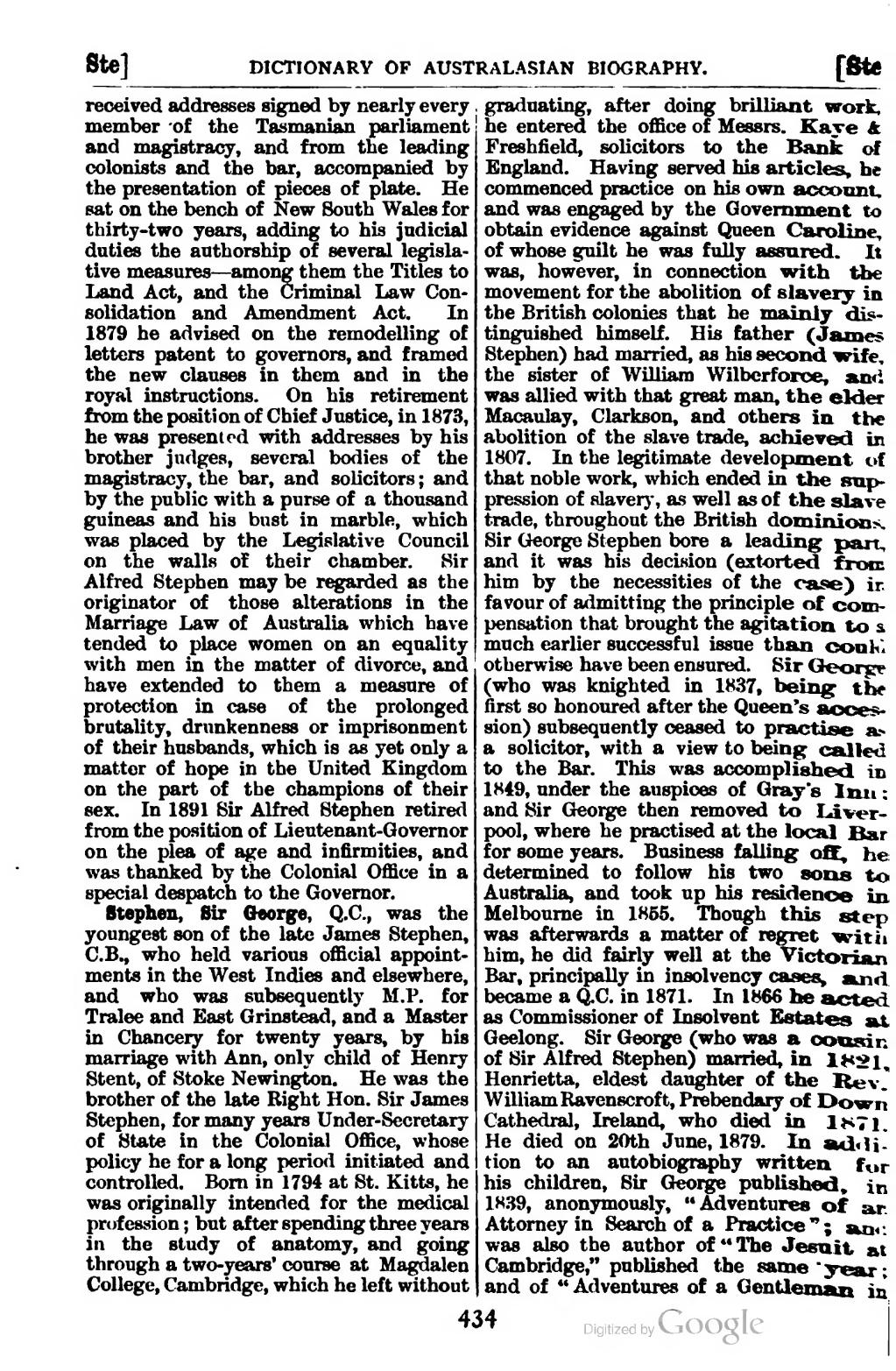received addresses signed by nearly every member of the Tasmanian parliament and magistracy, and from the leading colonists and the bar, accompanied by the presentation of pieces of plate. He sat on the bench of New South Wales for thirty-two years, adding to his judicial duties the authorship of several legislative measures—among them the Titles to Land Act, and the Criminal Law Consolidation and Amendment Act. In 1879 he advised on the remodelling of letters patent to governors, and framed the new clauses in them and in the royal instructions. On his retirement from the position of Chief Justice, in 1873, he was presented with addresses by his brother judges, several bodies of the magistracy, the bar, and solicitors; and by the public with a purse of a thousand guineas and his bust in marble, which was placed by the Legislative Council on the walls of their chamber. Sir Alfred Stephen may be regarded as the originator of those alterations in the Marriage Law of Australia which have tended to place women on an equality with men in the matter of divorce, and have extended to them a measure of protection in case of the prolonged brutality, drunkenness or imprisonment of their husbands, which is as yet only a matter of hope in the United Kingdom on the part of the champions of their sex. In 1891 Sir Alfred Stephen retired from the position of Lieutenant-Governor on the plea of age and infirmities, and was thanked by the Colonial Office in a special despatch to the Governor.
Stephen, Sir George, Q.C., was the youngest son of the late James Stephen, C.B., who held various official appointments in the West Indies and elsewhere, and who was subsequently M.P. for Tralee and East Grinstead, and a Master in Chancery for twenty years, by his marriage with Ann, only child of Henry Stent, of Stoke Newington. He was the brother of the late Right Hon. Sir James Stephen, for many years Under-Secretary of State in the Colonial Office, whose policy he for a long period initiated and controlled. Born in 1794 at St. Kitts, he was originally intended for the medical profession; but after spending three years in the study of anatomy, and going through a two-years' course at Magdalen College, Cambridge, which he left without graduating, after doing brilliant work, he entered the office of Messrs. Kaye & Freshfield, solicitors to the Bank of England. Having served his articles, he commenced practice on his own account, and was engaged by the Government to obtain evidence against Queen Caroline, of whose guilt he was fully assured. It was, however, in connection with the movement for the abolition of slavery in the British colonies that he mainly distinguished himself. His father (James Stephen) had married, as his second wife, the sister of William Wilberforce, and was allied with that great man, the elder Macaulay, Clarkson, and others in the abolition of the slave trade, achieved in 1807. In the legitimate development of that noble work, which ended in the suppression of slavery, as well as of the slave trade, throughout the British dominions. Sir George Stephen bore a leading part, and it was his decision (extorted from him by the necessities of the case) in favour of admitting the principle of compensation that brought the agitation to a much earlier successful issue than could otherwise have been ensured. Sir George (who was knighted in 1837, being the first so honoured after the Queen's accession) subsequently ceased to practise as a solicitor, with a view to being called to the Bar. This was accomplished, in 1849, under the auspices of Gray's Inn; and Sir George then removed to Liverpool, where he practised at the local Bar for some years. Business falling off, he determined to follow his two sons to Australia, and took up his residence in Melbourne in 1855. Though this step was afterwards a matter of regret with him, he did fairly well at the Victorian Bar, principally in insolvency cases, and became a Q.C. in 1871. In 1866 he acted as Commissioner of Insolvent Estates at Geelong. Sir George (who was a cousin of Sir Alfred Stephen) married, in 1821, Henrietta, eldest daughter of the Rev. William Ravenscroft, Prebendary of Down Cathedral, Ireland, who died in 1871. He died on 20th June, 1879. In addition to an autobiography written for his children, Sir George published, in 1839, anonymously, "Adventures of an Attorney in Search of a Practice"; and was also the author of "The Jesuit at Cambridge," published the same year; and of "Adventures of a Gentleman in
434
